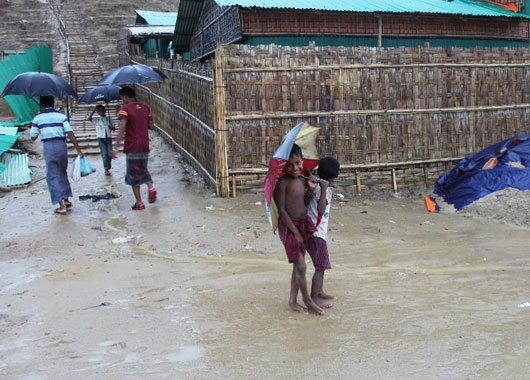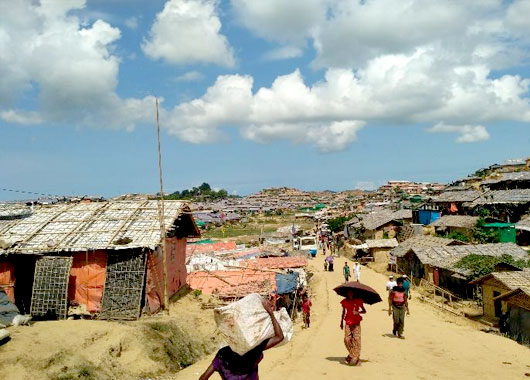
Field Story By Delhi Rose, Project coordinator at RedR India
After the influx from the Rohingya community in the border of Cox Bazaar in Bangladesh, as of 17 October, the Inter-Sector Coordination Group (ISCG) reported that an estimated 582,0001 people had entered Bangladesh.
I recently had an opportunity to work in the Rohingya refugee camp for 45 days as a RedR India volunteer. I was deployed to Christian Aid for their ongoing Shelter project. The shelter project was designed to strengthen the capacities of stakeholders in the design and construction of shelters in post-disaster settings through Real-Time Capacity Building (RTCB). The target was to ensure proactive capacity building of local artisans and affected community, to allow them to better incorporate disaster risk reduction features in shelters and other community buildings. This would help to be better prepared in case of a disaster and to minimize sufferings post-disaster. A Training of Trainers (ToT) session on shelter upgradation was an integral part of the capacity building grant to be provided to the targeted households in the project area.
As Training Coordinator, I was responsible for completing the Training of Trainers of the masons, the BDC members, the individual households on strengthening and upgrading the existing shelters through DRR methods to brave the impending storm. Cox bazaar was also prone to cyclones and storms during the monsoons because of its geographical location. The target for our team was to provide capacity building training and upgrade all the shelters in camps 15, 12 and 19 which was allotted to Christian Aid. Monsoon had already started by the time I arrived in May, hence the process to build the capacity of the people had to be faster.
I have had experience of working in the camps earlier with the IDPs in Assam. Those camps usually have 2000 HH at the max, but here each camp had a population of some 5000 HH, and there were multiple camps. When I first visited the Rohingya camps, the first thing that caught my eyes was the sheer number of people who were milling around. It seemed like an unending sea of tarpaulin across the camps. The houses were tightly cramped up as there was no space. The camp was teeming with activities; some collecting relief materials, some trying to rebuild their houses, some trying to make a living by doing odd jobs. There were small shops inside the relief camps as well.


As I interacted more with the Rohingya people, I had a realization that each house had a unique story to tell. Many of them narrated how they had to flee from their homes to arrive for safety. Many recounted their horror and did not want to go back; some fondly recalled their homes and even the plants that they grew there. But despite the grimness of the situation they are facing, the scarcity of resources and the unpredictable future ahead, they showed a lot of resilience.
You can see that among the children and young people. They are not dreadful of the future but they have hopes and dreams. Their smiles and laughter almost bring a sense of normalcy around.
I was going back from camp 15 one rainy afternoon after a training session with the BDC members when I saw children playing football outside. They were totally engrossed in the game, laughing and smiling with their friends. At that time the football World cup was going on, and the football fever had even caught on the camps with different people rooting for their favourite teams. Football discussions quickly became an easy starting point of conversation with the youth there. Everywhere there were children playing football wherever they get a chance.
There is a massive rain, there is this worry about where your next meal is going to be, the past that you have gone through and other worries that continually reminds you of the situation you are in and then there are these moments when you see a flicker of happiness in the moment of this cloudy days.
I could not help but remember this quote by Bob Marley
“Some people feel the rain, others just get wet.”
In spite of the tragedy they were faced with, I also saw the strength of the community to live and struggle through their lives. They continue to work hard.
When I asked some of the people where they get their strength to carry on, they tell me that they have faith in Allah and that keeps them going. It was not a surprise that many, if not all were maintaining their fast for the month of Ramadan even during the tough times.
During my 45 days in Cox Bazaar for the project, we held a number of training for Majhis, BDC members and households on DRR shelter upgradation, however, I learned more than just technical aspects in my time there.
It was not just the community who showcased extraordinary resilience in the face of adversity. I was also lucky to get an opportunity to work with a different individual who was selflessly working even at odd hours and challenging conditions, which were beyond any notions of working hours to meet the basic humanitarian needs of the Rohingya people. Many of these were often the community volunteers and office drivers who are always willing to support even beyond their duty hours.



Hi, this is a comment.
To get started with moderating, editing, and deleting comments, please visit the Comments screen in the dashboard.
Commenter avatars come from Gravatar.